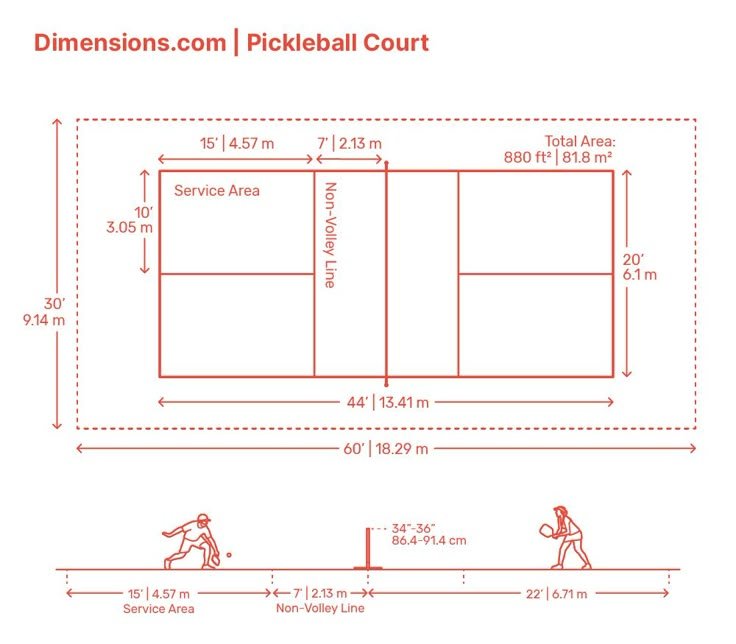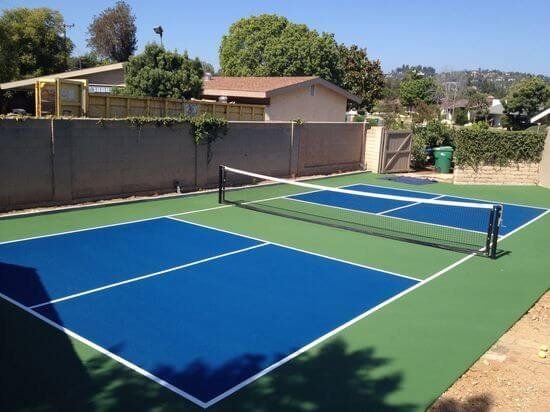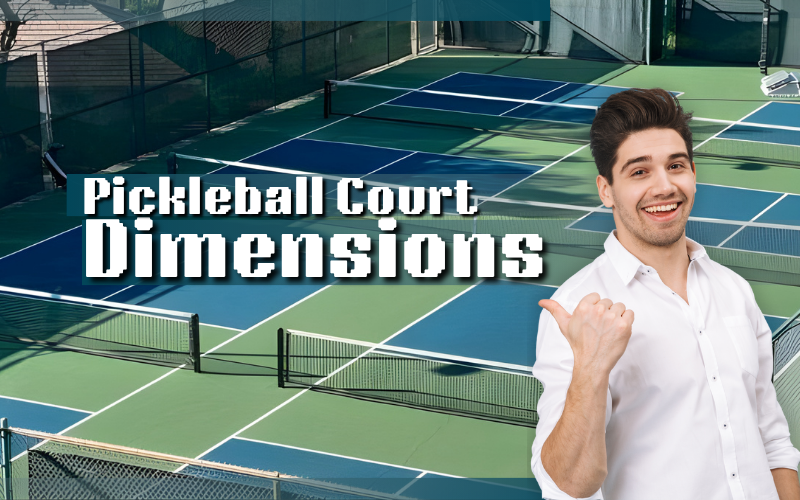Pickleball is taking the world by storm, blending the best of tennis, badminton, and ping-pong into a fun, accessible sport. Whether you’re a seasoned player or a curious newbie, understanding pickleball court dimensions is key to enjoying the game, setting up a court, or even designing one at home.
From official dimensions to DIY tips, we’ve got you covered with accurate, user-friendly insights.
What Are Pickleball Court Dimensions?
The pickleball court dimensions are standardized to ensure fair play across recreational and professional settings. A pickleball court measures 44 feet long by 20 feet wide for both singles and doubles play, with a total area of 880 square feet. This compact size makes pickleball courts smaller than tennis courts, which is one reason the sport is so versatile—it fits in smaller spaces!

The court is divided into specific zones, including the non-volley zone (NVZ), often called the “kitchen,” and service areas. These zones have precise measurements that affect gameplay strategy. Below, we’ll explore each part of the court in detail, complete with tables for easy reference.
Why Court Size Matters
Understanding pickleball court dimensions helps players:
- Strategize gameplay: Knowing the court’s layout aids in positioning and shot selection.
- Build accurate courts: Whether for home or community use, precise measurements ensure compliance with official rules.
- Compare with other sports: Pickleball’s compact size makes it easier to convert existing spaces, like tennis courts, for dual use.
At Sizescalematch.com, we simplify sizing so you can focus on enjoying the game. Let’s break down the court’s components.
Official Pickleball Court Dimensions: A Detailed Breakdown
The pickleball court dimensions are set by the USA Pickleball Association (USAPA) and the International Federation of Pickleball (IFP). These measurements ensure consistency worldwide. Here’s a detailed look at each part of the court:
1. Overall Court Size
- Length: 44 feet (13.41 meters)
- Width: 20 feet (6.10 meters)
- Total Area: 880 square feet (81.75 square meters)
This size applies to both singles and doubles play, making pickleball courts highly efficient.
2. Non-Volley Zone (NVZ or “Kitchen”)
The NVZ is a 7-foot-deep area on both sides of the net, extending the full 20-foot width of the court. Players cannot volley (hit the ball without letting it bounce) while standing in this zone, which adds a strategic layer to the game.
- Length: 7 feet (2.13 meters) from the net to the NVZ line
- Width: 20 feet (6.10 meters)
3. Service Areas
The court is divided into two service areas on each side, separated by the centerline. Each service area measures:
- Length: 15 feet (4.57 meters) from the NVZ line to the baseline
- Width: 10 feet (3.05 meters)
4. Net Height
The net runs across the court’s center, with specific height requirements:
- Center Height: 34 inches (0.86 meters)
- Sideline Height: 36 inches (0.91 meters)
5. Surrounding Space
For safety and comfort, official rules recommend a minimum 8-foot buffer around the court, making the total recommended area:
- Length: 60 feet (18.29 meters)
- Width: 30 feet (9.14 meters)
Here’s a quick reference table summarizing pickleball court dimensions:
| Component | Imperial (Feet/Inches) | Metric (Meters) |
|---|---|---|
| Court Length | 44 feet | 13.41 m |
| Court Width | 20 feet | 6.10 m |
| Non-Volley Zone (NVZ) Length | 7 feet | 2.13 m |
| Service Area Length | 15 feet | 4.57 m |
| Service Area Width | 10 feet | 3.05 m |
| Net Height (Center) | 34 inches | 0.86 m |
| Net Height (Sides) | 36 inches | 0.91 m |
| Recommended Total Area | 60 x 30 feet | 18.29 x 9.14 m |
This table is your go-to for quick conversions, whether you’re measuring in feet or meters. At Sizescalematch.com, we make it easy to compare measurements for all your sizing needs.
How Pickleball Court Dimensions Compare to Other Sports
Pickleball’s compact size is a major draw, especially compared to larger courts like tennis or basketball. Here’s how pickleball court dimensions stack up:
| Sport | Court Dimensions (Feet) | Total Area (Square Feet) |
|---|---|---|
| Pickleball | 44 x 20 | 880 |
| Tennis (Singles) | 78 x 27 | 2,106 |
| Badminton | 44 x 17 | 748 |
| Basketball (NBA) | 94 x 50 | 4,700 |
Pickleball courts are similar in length to badminton courts but slightly wider, and they’re much smaller than tennis courts. This makes pickleball ideal for community centers, backyards, or multi-use facilities. Converting a tennis court into multiple pickleball courts is common—one tennis court can fit four pickleball courts!
Building Your Own Pickleball Court: Measurements and Tips
Dreaming of your own pickleball court? Whether it’s for your backyard or a community space, understanding pickleball court dimensions is the first step. Here’s a step-by-step guide to get you started:
Step 1: Choose a Location
- Space Requirements: Ensure you have at least 44 x 20 feet for the court, plus an 8-foot buffer (60 x 30 feet total).
- Surface: Concrete or asphalt works best for durability. Indoor courts can use sport-specific flooring.
Step 2: Mark the Court
Use the official pickleball court dimensions:
- Baseline: Mark the 44-foot length.
- Sidelines: Mark the 20-foot width.
- NVZ Line: Measure 7 feet from the net on both sides.
- Centerline: Divide each side into two 10-foot-wide service areas.
Step 3: Install the Net
- Set posts 22 feet apart (center to center).
- Ensure the net is 36 inches high at the sides and 34 inches at the center.
Step 4: Add Surface and Lines
- Paint lines using weather-resistant paint (2 inches wide).
- Consider a cushioned surface for player comfort.
Cost Considerations
Building a pickleball court can cost between $15,000 and $40,000, depending on surface, fencing, and lighting. DIY courts using existing spaces (like driveways) can be much cheaper.
DIY Tip (Do It Yourself)
If space is tight, consider a half-court for practice (22 x 20 feet). While not ideal for competitive play, it’s great for drills or casual games.
Pickleball Court Dimensions for Different Settings
The pickleball court dimensions remain consistent, but the setup varies by setting. Here’s how courts differ:

1. Indoor vs. Outdoor Courts
- Indoor: Often use portable nets and temporary lines on multi-use floors. Ensure proper lighting (at least 300 lux).
- Outdoor: Require weather-resistant surfaces and nets. Wind can affect play, so consider windbreaks.
2. Recreational vs. Tournament Courts
- Recreational: May have slightly less buffer space but must follow standard pickleball court dimensions.
- Tournament: Require full 60 x 30 feet, high-quality surfaces, and spectator seating.
3. Multi-Use Facilities
Many facilities convert tennis or basketball courts for pickleball. Temporary lines or portable nets make this cost-effective.
Common Mistakes When Measuring Pickleball Court Dimensions
Avoid these pitfalls to ensure your court meets official standards:
- Incorrect NVZ Size: The kitchen must be exactly 7 feet deep. Misjudging this affects gameplay.
- Net Height Errors: Ensure the center is 34 inches, not level with the 36-inch sides.
- Inadequate Buffer Space: Less than 8 feet around the court can lead to safety issues.
- Ignoring Surface Slope: Outdoor courts need a slight slope (1%) for drainage but must remain level for play.
Double-check measurements with a tape measure and refer to our table above for accuracy.
Fun Facts About Pickleball Court Dimensions
- Origin: Pickleball was invented in 1965 on a badminton court, which is why its length matches badminton’s 44 feet.
- Kitchen Rule: The NVZ was added to prevent players from dominating the net, making the game more strategic.
- Portability: Pickleball’s compact size inspired portable court kits, perfect for temporary setups.
How to Use Pickleball Court Dimensions for Better Gameplay
Knowing pickleball court dimensions isn’t just for builders—it’s a game-changer for players. Here’s how to leverage court size:
- Master the Kitchen: Stay out of the NVZ during volleys to avoid faults. Practice dinks (soft shots) to control this zone.
- Serve Smart: Use the 15-foot service area to aim deep, forcing opponents back.
- Positioning: In doubles, coordinate with your partner to cover the 20-foot width effectively.
Measurement Conversion Table for Global Players
Pickleball is played worldwide, so we’ve included a conversion table for pickleball court dimensions in both imperial and metric units:
| Component | Feet/Inches | Meters | Centimeters |
|---|---|---|---|
| Court Length | 44 feet | 13.41 m | 1341 cm |
| Court Width | 20 feet | 6.10 m | 610 cm |
| NVZ Length | 7 feet | 2.13 m | 213 cm |
| Service Area Width | 10 feet | 3.05 m | 305 cm |
| Net Height (Center) | 34 inches | 0.86 m | 86 cm |
Why Trust Sizescalematch.com for Pickleball Court Dimensions?
At Sizescalematch.com, we’re dedicated to providing accurate, user-friendly measurements for all your sizing needs. Our team researches official standards, like those from the USAPA, to ensure our guides are trustworthy. Whether you’re comparing pickleball court sizes to tennis courts or building your own, we simplify the process with clear tables and practical tips. Our mission is to be your ultimate size library, helping you make informed decisions with confidence.
FAQs About Pickleball Court Dimensions
1. Can I play pickleball on a tennis court?
Yes! A tennis court can fit up to four pickleball courts. Use temporary lines to mark the pickleball court dimensions (44 x 20 feet).
2. What’s the minimum space needed for a pickleball court?
The court itself is 44 x 20 feet, but a 60 x 30-foot area is recommended for safety.
3. Why is the NVZ called the “kitchen”?
The term comes from shuffleboard, where the scoring area was nicknamed the “kitchen.” It stuck in pickleball for the NVZ.
4. How much does it cost to build a pickleball court?
Costs range from $15,000 to $40,000, depending on surface, fencing, and location.
If you are Blessing Lover!! Then Blessing Read is just for you!!
